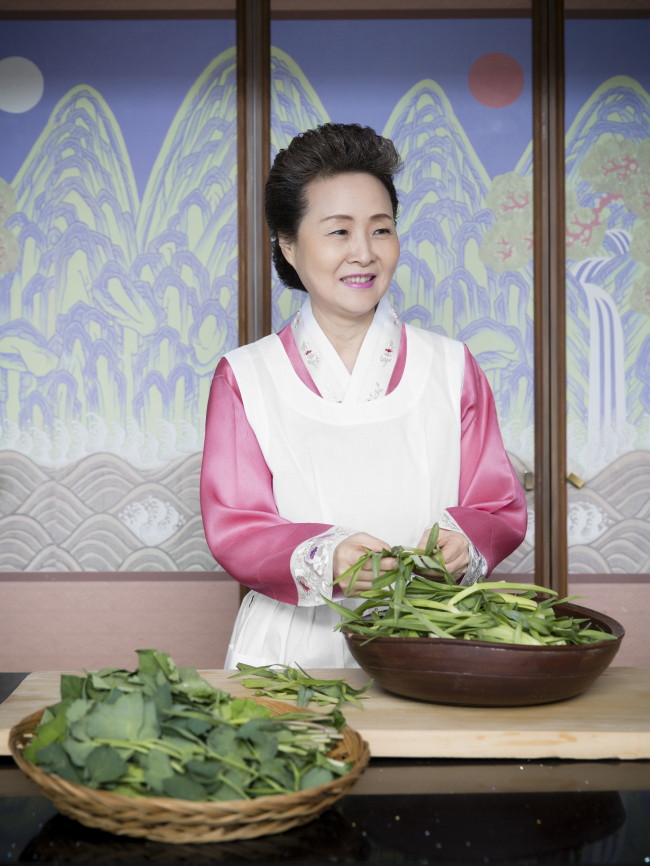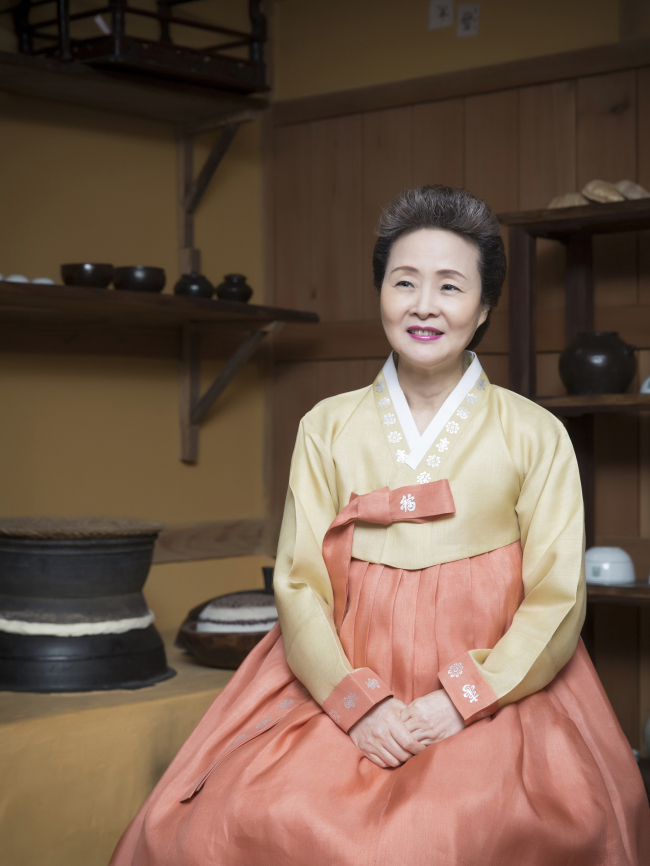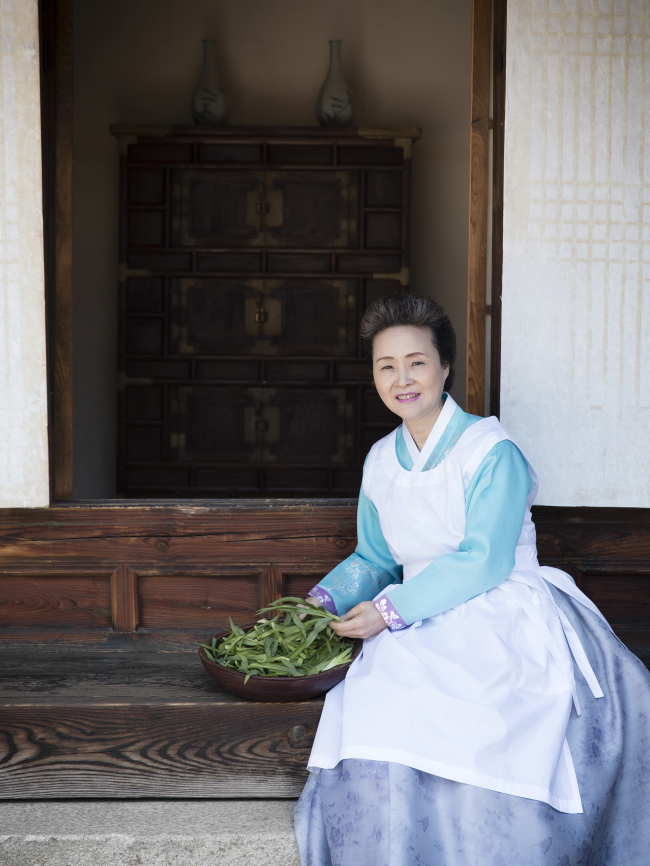[Eye Interview] 'Hansik is about consideration for others’
Korean Food Foundation head Yoon Sook-ja aims to imbue Korean cuisine with culture in promoting hansik abroad
By Korea HeraldPublished : June 3, 2016 - 16:58
Wearing a delicate traditional Korean hanbok made of a light jade skirt and cream top, Yoon Sook-ja, chairwoman of the Korean Food Foundation, is the quintessential host -- elegant and ever so considerate of guests. Aware that the interview schedule precluded lunch, she had her staff pick up kimbap from a store in the building. If she noticed the small paper cup of water was half empty, she paused between sentences to fill it.
“Hansik is about consideration for the diner,” said Yoon, who, before taking the helm at the state-run foundation in April taught Korean cuisine at Baewha Women’s University until 2002. In 2002, she founded the Tteok Museum near Changdeokgung Palace in downtown Seoul.
Her efforts to make traditional Korea rice cakes, or tteok, easier to make and enjoy have earned her a number of titles as a prize-winning inventor in several countries. Her invention, a package containing tteok, can be kept for six months. “It is there for companies to commercialize, but no one has expressed real interest yet,” she said.

Yoon, the fourth chairwoman of the Korean Food Foundation, is the first “hansik,” or Korean food, specialist to head the organization charged with promoting Korean cuisine around the world, and as such, expectations are high.
Yet, Yoon is determined to keep things realistic. “I don’t have a grandiose plan,” Yoon said in her unassuming yet quietly charismatic manner. “Just this morning, we had a meeting where we discussed the need to define the foundation’s identity and to do what needs to be done,” she said.
One of Yoon’s priorities is to gather all information and content related to hansik scattered throughout the country to one central place. “This way, we can correct errors, avoid redundancies and strengthen the organization’s foundation,” she said. Such information could then be used by the business sector to create new products and services.
The dearth of skilled hansik chefs is another concern that Yoon wishes to rectify. She vowed to make hansik education more readily available and to create a database of hansik chefs that would be made available to the public on the foundation’s website. “This way, hansik restaurants, both in Korea and abroad can more easily recruit skilled hansik chefs,” Yoon explained.

Such effort would, in turn, lead to an improvement in hansik offerings abroad, Yoon projected. Right now, most Korean restaurants and eateries outside the country are run by nonprofessionals, which hampers efforts to raise hansik to the level of fine dining.
“Globalizing of cuisine is a slow process, but I think adding cultural elements to cuisine, such as storytelling, will aid in the process,” Yoon said. She is hopeful the plan to enshrine Korea’s jang, or fermented bean paste, culture and ancestral rites culture in UNESCO World Heritage will prove successful. “It will greatly boost hansik’s stature,” she said.
Explaining that getting food listed under the umbrella of UNESCO World Heritage is very difficult -- kimchi made it to the list in 2013 when it applied as kimchi-making culture -- Yoon said the making of jang and ancestral rites are unique Korea cultures involving food.
“We make jang in the first month of the lunar calendar, picking an auspicious date. Brine solution used in the making of jang is prepared 10 days in advance and women bathe themselves before starting to make jang,” Yoon said. Bathing, in Korean culture, is more than merely cleansing the body -- it is an act of purification, both physical and spiritual.
“As for ancestral rites, it is an occasion when, once a year, all the family members gather to remember the deceased, sharing food. It is as if our ancestors are creating an opportunity for us to renew our family bonds every year,” she said. The UNESCO applications are planned for next year, Yoon added.

The 2018 PyeongChang Winter Olympics will come as an opportunity to globalize hansik, according to Yoon. The Korean Food Foundation plans to develop a few representative items that will be heavily promoted during the international sporting event. “We will operate a food culture pavilion at the venue and promote the selected dishes,” she elaborated.
As for how to go about globalizing hansik, Yoon said, “It is about presenting proper Korean cuisine to people around the world.” This should involve both traditional and modern hansik, according to Yoon. “Traditional hansik includes regional food, ceremonial food, seasonal food, Buddhist temple food, royal cuisine, fermented food, tteok, our desserts and tea that are presented in their unchanged, traditional form,” she said, naming the different categories of food all in one breath. “By modern hansik, I do not mean fusion food. It should be based on traditional food,but should be modified for the target market,” Yoon said, adding, “It should use ingredients that are available today and employ contemporary cooking methods and contemporary plating.”
Returning to her earlier remark that globalization of hansik has been a slow process, she said, “The table setting where everything, including numerous side dishes, is presented all at once is a Joseon-era custom.” Pointing out that this custom of serving “banchan,” or side dishes, is a burden on Korean restaurants, she urged serving fewer side dishes, adding, “Restaurants should charge for banchan and customers should expect to pay.”
Standardization of recipes is crucial to globalizing hansik, Yoon emphasized. “There is too much oral tradition in Korean cuisine. There are virtually no written recipes,” she said. Keenly aware of the problem, Yoon, in 2006, embarked on a more than three-year project to standardize recipes. The result was a book of 100 Korean dishes that was made available in eight languages. Another volume of 300 dishes is used as a textbook in advanced hansik classes in colleges. “We standardized the measuring units, described the exact measurement of the cookware used, gave nutritional analysis of each dish and showed how the dishes should be presented,” she said.
While preserving the authenticity of Korean cuisine is important, localization is very important overseas, according to Yoon. “We have to capture the palate of the local people,” she said.
As for Koreans’ “lack of respect” for Korean cuisine that has hindered the development of Korean fine dining establishments, Yoon blamed ignorance.
“We do not know the merits of our own food,” she said. For example, Korean cuisine is seasonal, ensuring the best nutritional value. It makes heavy use of slowly fermented foods known to have health benefits. “Even this common kimbap is a balanced meal with its stuffing of different colored vegetables,” Yoon pointed out, picking up a piece of kimbap.
“Hansik is all about consideration for those who will be eating the food,” Yoon said. “If we realize the philosophy behind hansik, we will surely appreciate it more.”
By Kim Hoo-ran (khooran@heraldcorp.com)
-
Articles by Korea Herald



![[AtoZ into Korean mind] Humor in Korea: Navigating the line between what's funny and not](http://res.heraldm.com/phpwas/restmb_idxmake.php?idx=644&simg=/content/image/2024/04/22/20240422050642_0.jpg&u=)

![[Exclusive] Korean military set to ban iPhones over 'security' concerns](http://res.heraldm.com/phpwas/restmb_idxmake.php?idx=644&simg=/content/image/2024/04/23/20240423050599_0.jpg&u=20240423183955)

![[Herald Interview] Why Toss invited hackers to penetrate its system](http://res.heraldm.com/phpwas/restmb_idxmake.php?idx=644&simg=/content/image/2024/04/22/20240422050569_0.jpg&u=20240422150649)
![[Graphic News] 77% of young Koreans still financially dependent](http://res.heraldm.com/phpwas/restmb_idxmake.php?idx=644&simg=/content/image/2024/04/22/20240422050762_0.gif&u=)







![[Exclusive] Korean military to ban iPhones over security issues](http://res.heraldm.com/phpwas/restmb_idxmake.php?idx=652&simg=/content/image/2024/04/23/20240423050599_0.jpg&u=20240423183955)



![[Today’s K-pop] Ateez confirms US tour details](http://res.heraldm.com/phpwas/restmb_idxmake.php?idx=642&simg=/content/image/2024/04/23/20240423050700_0.jpg&u=)